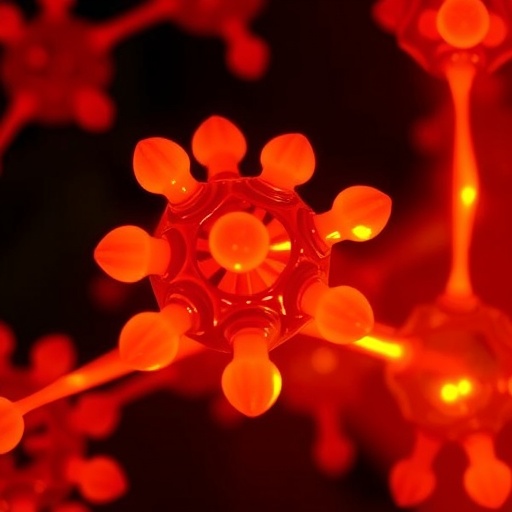Recent innovations in photocatalytic materials have evaded the boundaries of traditional methodologies, paving the way for promising applications in environmental remediation. A enlightening study has emerged focusing on the synthesis and characterization of a novel material, a multi-walled carbon nanotube (MWCNT) integrated copper-based metal-organic framework (Cu-BDC MOF). This innovative composite has exhibited remarkable potential in the photocatalytic degradation of methylene blue dye, a widely used textile dye known for its persistent nature in the environment. Given that organic dyes, including methylene blue, pose significant environmental threats, effective degradation strategies are vital.
The research, led by Maan and colleagues, meticulously details the intricate synthesis process of the MWCNT integrated Cu-BDC MOF. The incorporation of multi-walled carbon nanotubes into the MOF matrix is not merely an enhancement; rather, it is a transformative step structured to amplify the material’s photocatalytic activity. The underlying chemistry reflects a complex interrelationship where the physical structure and electrochemical properties work synergistically to optimize photocatalytic performance.
One of the pivotal aspects of this study is the emphasis on the characterization techniques employed. The team utilized a series of state-of-the-art analytical methods, including X-ray diffraction (XRD), scanning electron microscopy (SEM), and Fourier-transform infrared spectroscopy (FTIR), among others. Each of these techniques served a specific purpose: XRD elucidated the crystalline structure of the Cu-BDC MOF, while SEM provided insights into the morphology and dispersion of the MWCNTs within the structure.
The photocatalytic mechanisms at play in this innovative composite demonstrate a well-orchestrated synchronization between the Cu-BDC MOF and MWCNTs. By integrating MWCNTs, the researchers aimed to enhance the charge separation process, a critical factor that influences photocatalytic efficiency. The formation of reactive oxygen species (ROS) under UV light irradiation is significantly influenced by the structural and electronic properties of this hybrid material, thus facilitating the breakdown of the robust methylene blue molecule.
Moreover, the study highlighted the tunable nature of the Cu-BDC MOF’s porous structure, which allows for optimal adsorption of the dye molecules. Increased surface area and porosity are paramount advantages offered through the integration of MWCNTs, facilitating higher interaction rates between the photocatalyst and the pollutant. This interplay is essential for achieving a swift degradation rate, minimizing the time required for effective environmental remediation.
Test conditions meticulously designed in the experimental framework included variations in pH levels, dye concentration, and catalyst dose. These parameters were carefully optimized to understand their individual impacts on degradation kinetics. Results from the experiments indicated that specific conditions maximized degradation efficiency, reinforcing the notion that environmental factors play a critical role in photocatalytic processes.
Quantifying the performance of the MWCNT integrated Cu-BDC MOF is crucial for assessing its practical applicability. The researchers reported impressive degradation rates which surpassed those of conventional photocatalysts, showcasing this new composite’s utility in real-world applications. The degradation kinetics followed first-order reaction dynamics, aligning well with established models in photocatalysis literature.
The implications of this research extend far beyond the laboratory setting. The enhanced photocatalytic activity demonstrated by the composite material opens numerous avenues for tackling wastewater treatment challenges. Textiles and dye manufacturing industries, notorious for their substantial water pollution footprints, stand to benefit immensely from the adoption of such advanced materials.
In conclusion, the synthesis and characterization of MWCNT-integrated Cu-BDC MOF introduce a transformative approach to photocatalytic degradation technologies. Not only does this study shed light on a promising new composite, but it also reinforces the urgent need for innovative solutions to mitigate environmental pollution. The future implications of this research could vastly improve the methods through which we combat hazardous pollutants and navigate the complexities of environmental sustainability.
The research community eagerly anticipates the next steps in this trajectory. Following this foundational study, further investigations could explore scalability, long-term stability, and broader applicability within diverse environmental contexts. As the discourse on sustainable technologies continues to gain momentum, the findings of this research could serve as a cornerstone for future advancements in photocatalytic materials.
Promising developments such as these invoke a sense of hope within the environmental sciences realm. With continuous innovation and dedicated research, the collective goal of achieving a sustainable and pollution-free environment becomes increasingly attainable. The potential for widespread adoption of advanced photocatalytic systems not only provides a pathway for cleaner industries but also underlines a commitment to preserving the ecological balance necessary for our planet’s future.
As we look towards the horizon of scientific innovation, the integration of advanced materials in combating environmental challenges remains a pressing priority. The ongoing journey in the realm of photocatalysis highlights the collaborative spirit of scientific inquiry, driven by the collective vision of a cleaner, more sustainable world.
Subject of Research: The enhancement of photocatalytic degradation of methylene blue dye using MWCNT integrated Cu-BDC MOF.
Article Title: Study on synthesis and characterizations of MWCNT integrated Cu-BDC MOF for enhanced photocatalytic degradation of methylene blue dye.
Article References:
Maan, D., Kumar, A., Jain, K. et al. Study on synthesis and characterizations of MWCNT integrated Cu-BDC MOF for enhanced photocatalytic degradation of methylene blue dye. Environ Sci Pollut Res (2025). https://doi.org/10.1007/s11356-025-36818-1
Image Credits: AI Generated
DOI: 10.1007/s11356-025-36818-1
Keywords: photocatalysis, MWCNT, Cu-BDC MOF, methylene blue degradation, environmental remediation




